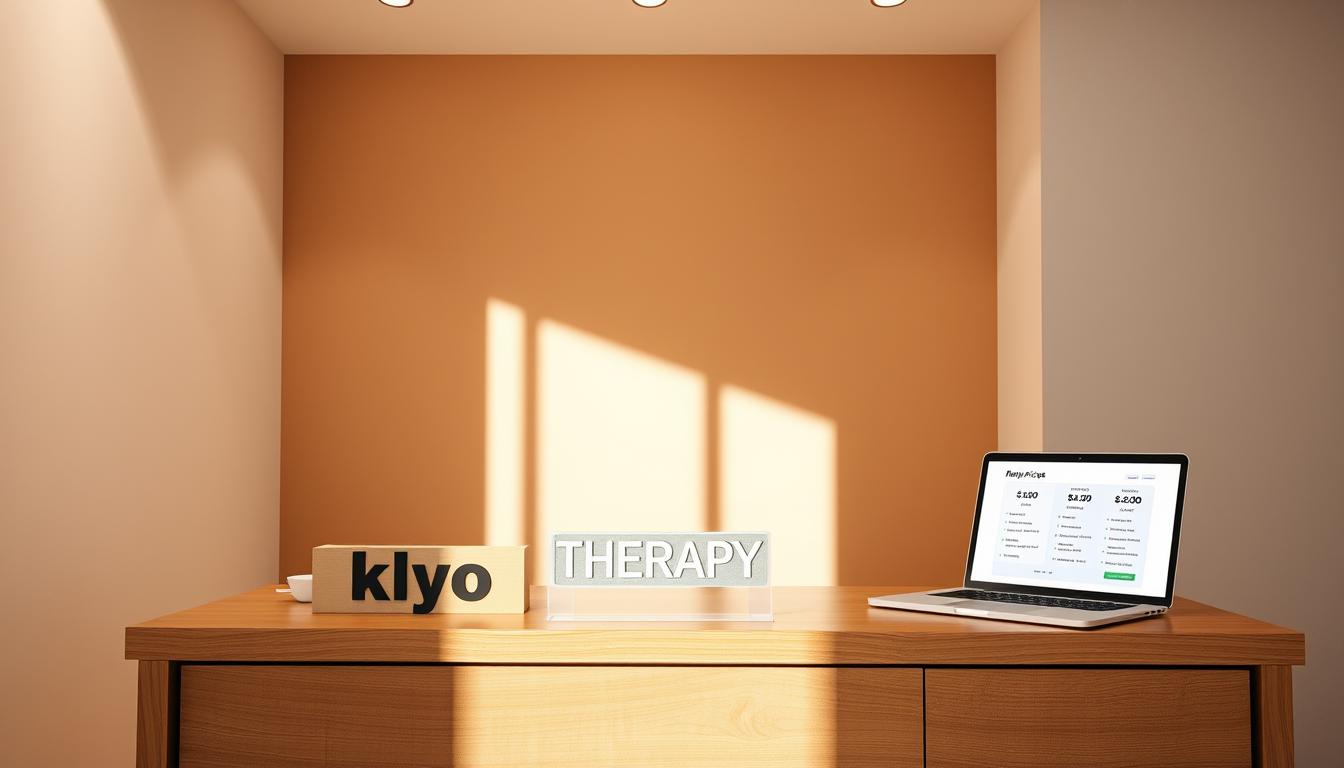I am a participant in the Amazon Services LLC Associates Program, an affiliate advertising program designed to provide a means for sites to earn advertising fees by advertising and linking to Amazon.com and affiliated sites. This post contains affiliate links. Privacy Policy
How Much Does Therapy Cost in the US?
Knowing the cost of therapy is key to good mental health care choices. The price of mental health services changes a lot. This depends on where you are, the type of therapy, and the therapist’s skills.

Ever thought about what makes therapy pricing different? Or how to find counseling costs that fit your budget? Figuring these out can guide you through the US’s mental health service world.
Best brain supplement!
Key Takeaways
- The cost of therapy varies widely across the US.
- Factors such as location and therapist qualifications impact therapy cost.
- Understanding your insurance coverage is crucial for managing mental health services costs.
- Different types of therapy have different pricing structures.
- Researching and comparing prices can help you find affordable options.
The Current Landscape of Therapy Costs in America
When you think about therapy, knowing the costs is key. The price of therapy can change a lot. This depends on where you are, the therapist’s skills, and the type of therapy.
Average Session Rates Across the Country
In the United States, therapy sessions usually cost between $100 and $200. Some therapists might charge more because of their experience or where they are. Here’s a simple guide to average costs in different places:
| Therapy Setting | Average Cost per Session |
|---|---|
| Private Practice | $120-$250 |
| Community Clinics | $20-$100 |
| Online Therapy Platforms | $60-$150 |
Regional Cost Variations
Costs can also vary by region. For example, therapy in big cities like New York or California is pricier than in smaller towns. Here’s a quick look at what you might expect to pay in different areas:
| Region | Average Therapy Cost per Session |
|---|---|
| Northeast | $150-$300 |
| South | $100-$200 |
| West Coast | $120-$250 |
How Much Does Therapy Cost Without Insurance?
Understanding the costs of therapy without insurance is key to making good choices for your mental health. The price of therapy can change a lot. This depends on the therapist’s skills, where they are, and what kind of therapy you need.
Private Practice Rates can vary a lot. Therapists in private practice set their own prices. They consider their skills, how much demand there is, and their costs. On average, you might pay between $100 to $250 for a session. Some therapists might charge more, especially if they have more education or special training.
Private Practice Rates
Therapists in private practice usually charge based on their skills and the local market. For example, a therapist with many years of experience might charge about $150 per session. Always ask about their rates when you first meet them.
A mental health expert said, “The cost of therapy is an investment in your well-being. It may seem expensive, but the benefits can be huge and last a long time.“
Sliding Scale Options
If you don’t have insurance, many therapists offer sliding scale fees. These fees are based on how much you make or your financial situation. This can make therapy cheaper, making it more reachable. Some community clinics and training clinics also offer affordable therapy on a sliding scale.
- Sliding scale fees can be from $20 to $100 per session.
- Some therapists might offer deals or discounts if you book more sessions.
- Talking openly about your financial situation with your therapist is important. This way, you can find a rate that works for you.
By looking into these options and talking to potential therapists, you can find therapy that fits your budget. This way, you can also reach your mental health goals.
Different Types of Therapy and Their Price Points
It’s important to know about the various types of therapy and their costs. This knowledge helps you make better choices for your mental health. The type of therapy you pick can greatly affect how much you’ll pay.
Individual Therapy Costs
Individual therapy is when you meet one-on-one with a therapist. It’s very common. The price for a session can be between $100 and $250. This depends on where you are, the therapist’s experience, and how long the session is.
On average, expect to pay about $150 for a session.
Couples and Family Therapy Pricing
Couples and family therapy involve more people and cost more. Sessions for couples can be from $150 to $300. Family therapy sessions might be $200 to $350. These sessions usually last longer, from 60 to 90 minutes.
Group Therapy as a Cost-Effective Alternative
Group therapy is when one therapist works with several people with similar issues. It’s often cheaper. The cost per session can be from $30 to $100. This makes it a good choice if you’re watching your budget.
Group therapy not only saves money but also offers a supportive community.
| Therapy Type | Cost per Session | Session Duration |
|---|---|---|
| Individual Therapy | $100-$250 | 45-60 minutes |
| Couples Therapy | $150-$300 | 60-90 minutes |
| Family Therapy | $200-$350 | 60-90 minutes |
| Group Therapy | $30-$100 | 60-90 minutes |
The type of therapy you choose can really affect your costs. Think about what you need and your budget when picking a therapy type.
Factors That Influence Therapy Pricing
Knowing what affects therapy costs can help you choose the right mental health care. Many things can change how much therapy costs. Understanding these can make it easier to find what you need.
Therapist Credentials and Specialization
The skills and focus of your therapist can change the price. Those with more education or experience often charge more. For example, a Ph.D. or Psy.D. holder might cost more than someone with a master’s degree.
Also, if your therapist specializes in certain areas, like trauma or anxiety, it can raise the price.
Session Length and Frequency
The time and how often you see your therapist also matters. Most sessions last 45-60 minutes. Longer sessions cost more. Seeing your therapist more often, like weekly, will also increase the cost.
Practice Location and Overhead Costs
Where your therapist works and their costs can also affect the price. Therapists in big cities or with high costs, like a private office, might charge more. Those in smaller towns or with lower costs might be cheaper.
Online vs. In-Person Therapy Costs
Whether you see your therapist online or in person can also change the cost. Online therapy is becoming more popular. Some therapists might charge more for in-person sessions, possibly because of different costs or demand.
To understand how these factors work together, here’s a quick summary:
| Factor | Impact on Cost | Example |
|---|---|---|
| Therapist Credentials | Higher credentials = higher cost | Ph.D. vs. MA/MS |
| Session Length | Longer sessions = higher cost | 60 minutes vs. 90 minutes |
| Practice Location | Urban = higher cost than rural | City center vs. suburban area |
| Online vs. In-Person | Varies by therapist | Some charge the same, others differ |
Insurance Coverage for Mental Health Services
Getting insurance for mental health services is key in the US. With more people talking about mental health, knowing your insurance options is crucial. It helps you get the care you need.
Understanding Mental Health Parity Laws
Mental health parity laws make sure insurance covers mental health equally to physical health. The Mental Health Parity and Addiction Equity Act (MHPAEA) of 2008 is a big law that makes this happen.
These laws mean insurance can’t limit mental health treatment more than physical treatment. This includes things like copays and visit limits.
In-Network vs. Out-of-Network Coverage
Knowing the difference between in-network and out-of-network coverage is important. In-network providers work with your insurance at a set rate, which saves you money.
Out-of-network providers don’t have a deal with your insurance. Seeing them might cost more, and not all services are covered. Always check your insurance plan to know what’s covered and what might cost extra.
Navigating Insurance Reimbursement
Handling insurance reimbursement can be tough, but it’s key to getting the most from your benefits. First, make sure you know what your plan covers and any rules you must follow.
After you get care, your provider will send the bill to your insurance. If you had to pay out-of-pocket or saw someone not in your network, you might need to ask for reimbursement. Keeping track of your payments and talks with your insurance is important.
By knowing about mental health parity laws, the difference between in-network and out-of-network, and how to deal with insurance, you can make better choices. This helps you get the care you need without breaking the bank.
Finding Affordable Therapy Resources
Finding affordable therapy is possible with the right resources and information. You have several options to make therapy more accessible and affordable.
Some of the most affordable options include:
- Community Mental Health Centers: These centers provide mental health services at a reduced cost based on your income.
- University Training Clinics: Many psychology departments in universities offer low-cost therapy provided by trainees under supervision.
- Online Therapy Platforms: These platforms often offer more affordable rates than traditional in-person therapy.
- Employee Assistance Programs (EAPs): Many employers offer EAPs, which include a few sessions of free therapy.
Community Mental Health Centers
Community Mental Health Centers offer a range of services, including individual and group therapy, at a cost adjusted according to your income. To find one near you, you can visit the Substance Abuse and Mental Health Services Administration (SAMHSA) website.
University Training Clinics
University training clinics are another affordable option. Therapy is provided by graduate students under the supervision of licensed professionals. These clinics often offer a sliding scale fee based on your financial situation.
Online Therapy Platforms and Their Costs
Online therapy platforms like BetterHelp and Talkspace offer convenient and often more affordable therapy options. They provide various plans and pricing options, making it easier to find something that fits your budget.
Employee Assistance Programs (EAPs)
Many companies offer EAPs as part of their employee benefits package. These programs typically include a few sessions of free therapy with a licensed therapist. Check with your HR department to see if this benefit is available to you.
By exploring these options, you can find a therapy solution that fits your needs and budget.
Conclusion: Investing in Your Mental Health
Exploring therapy costs in the US shows that investing in mental health is key. Therapy costs can change a lot, but the benefits are huge. Knowing about session rates, cost differences by region, and what affects prices helps you choose wisely.
Looking into insurance, sliding scale fees, and online therapy can make mental health care more affordable. It’s not just about the money; it’s about improving your life. As you look into mental health options, remember that therapy costs are worth it for your well-being.
With the right information, you can manage your mental health journey. Whether it’s one-on-one therapy, couples counseling, or group sessions, find what fits your budget and needs. By focusing on your mental health, you’re building a brighter, stronger future.
FAQ
How much does a typical therapy session cost in the US?
Therapy session costs vary. On average, expect to pay between $100 to $250 per session. This depends on location, therapist credentials, and therapy type.
What factors influence the cost of therapy?
Several factors affect therapy costs. These include therapist credentials, session length, location, and whether it’s online or in-person.
How can I find affordable therapy options?
Look for community mental health centers, university clinics, online platforms, and EAPs. These can offer more affordable options that fit your budget.
Does insurance cover therapy costs?
Yes, many insurance plans cover mental health services. Knowing your coverage and how to use it can help you save money.
What is the difference between in-network and out-of-network therapy coverage?
In-network providers have a contract with your insurance. This means lower costs for you. Out-of-network providers charge more, and you might need to file a claim.
Are there any laws that protect mental health coverage?
Yes, mental health parity laws ensure equal coverage for mental health services. This means you get the care you need.
Can I negotiate the cost of therapy with my therapist?
Some therapists offer sliding scale fees based on your income. Discussing your financial situation with your therapist might help make therapy more affordable.
How do online therapy platforms compare in cost to traditional in-person therapy?
Online therapy is often cheaper. Sessions cost between $40 to $100. In-person therapy can cost $100 to $250 per session.
What are the average costs associated with different types of therapy?
Individual therapy costs $100 to $250 per session. Couples and family therapy can cost $150 to $300. Group therapy is more affordable, at $20 to $50 per session.
I am a participant in the Amazon Services LLC Associates Program, an affiliate advertising program designed to provide a means for sites to earn advertising fees by advertising and linking to Amazon.com and affiliated sites. This post contains affiliate links. Privacy Policy


